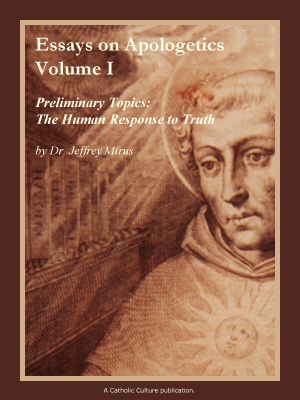Introduction to Lent
By Dr. Jeff Mirus ( bio - articles - email ) | Jan 24, 2012
Lent is the penitential season of approximately 40 days set aside by the Church in order for the faithful to prepare for the celebration of the Lord’s passion, death and resurrection. During this holy season, inextricably connected to the Paschal Mystery, the catechumens prepare for Christian initiation, and current Church members prepare for Easter by recalling their baptism and by works of penance, that is, prayer, fasting and almsgiving. As we enter Lent in this spirit of the Church and of her liturgy we seek to wash away the stains of sin and to rid ourselves of all that prevents us from living a truly Christian life.
Ash Wednesday is the clarion call to “Repent and believe the gospel” (Mk 1:15). For the next forty days, the faithful willingly submit to fasting and self-denial in imitation of Our Lord’s forty-day fast in the desert. It is in these dark and still nights, these desert-times, that the soul experiences its greatest growth. There, in the inner arena, the soul battles the world, the flesh and the devil just as Our Lord battled Satan’s triple temptation in the desert. His battle was external, for Jesus could not sin; our battle is interior, but with a hope sustained by the knowledge of Christ’s Easter victory over sin and death.
The word Lent is derived from an Anglo-Saxon word lengten or lencten meaning spring. We are “to spring” into action, to do the tasks of the season, to prepare for the new growth and graces that will overflow at Easter. In most places, Lent corresponds to Spring, the most important season for a farmer, in which he prepares the soil thoroughly and plants the seed carefully, hoping that the seed buried deep in the soil will produce an abundant crop.
On Palm Sunday, the very threshold of his death and Resurrection, Our Lord assured his followers that “unless the grain of wheat falls to the earth and dies, it remains just a grain of wheat. But if it dies, it produces much fruit. The man who loves his life loses it, while the man who hates his life in this world preserves it to life eternal” (Jn 12:24-25).
Because of this theme of dying in order to rise, the watchword for the liturgical celebrations of the Season of Lent is austerity. The Church has proclaimed a time of fasting and self-denial and she teaches by example. The priest is vested in violet, the gloomy color of affliction and mortification, except on the Fourth Sunday of Lent (Laetare Sunday) when he might choose the festive option of rose vestments. The sanctuary is bereft of flowers, and less ornate linens and candlesticks adorn the altar. The Gloria will not be prayed on Sunday, while the Alleluia will be entirely absent throughout Lent.
There are two exceptions to the Lenten austerity. On the Solemnities of St. Joseph (March 19) and the Annunciation (March 25) the Church sets aside her purple for white vestments, sings the Gloria and prays the Creed.
Throughout the season, the readings of the Lenten Liturgies give us daily lessons based on three major themes:
- The first three weeks call us to repentance and to the practice of virtue, though the Church will suspend her penitential readings on Laetare Sunday, the midway point of the Lenten journey, to rejoice that Easter is near.
- The second theme that threads its way through the seasonal readings is the instruction of the catechumens who are preparing for Easter-birth. The Rites of Christian Initiation span the season of Lent and culminate in the Easter Vigil Rites of Baptism and Confirmation of the Elect. The various readings put before our eyes many Old Testament characters and events that prefigure Christ and the Paschal Mystery: Christ is the new Adam, and he is the Isaac of the New Covenant; the Church is the new Ark which saves mankind through the waters of Baptism, and so on.
- The final scriptural theme unfolding in the last two weeks of Lent is the mounting opposition to Christ. The sixth and final Sunday of Lent (Passion or Palm Sunday) will usher in Holy Week, the greatest and holiest of all weeks. The liturgies of Holy Week and the Sacred Triduum are too rich to be summarized here.
Note that the penitential regulations of Lent are as follows in most dioceses of the Roman Rite:
- Abstinence on all the Fridays of Lent, and on Ash Wednesday and Good Friday. No meat may be eaten on days of abstinence. Catholics 14 years and older are bound to abstain from meat. Invalids, pregnant and nursing mothers are exempt.
- Fast on Ash Wednesday and Good Friday. Fasting means having only one full meal to maintain one’s strength. Two smaller, meatless and penitential meals are permitted according to one’s needs, but they should not together equal the one full meal. Eating solid foods between meals is not permitted. Catholics from age 18 through age 59 are bound to fast. Again, invalids, pregnant and nursing mothers are exempt.
This third volume of our Liturgical Year series covers all the days of Lent and the Sacred Triduum, from Ash Wednesday through Holy Saturday, the day before Easter. For more ideas, prayers and activities to assist families in living the liturgical season of Lent, we suggest that you visit the Lenten Workshop on CatholicCulture.org.
All comments are moderated. To lighten our editing burden, only current donors are allowed to Sound Off. If you are a current donor, log in to see the comment form; otherwise please support our work, and Sound Off!








